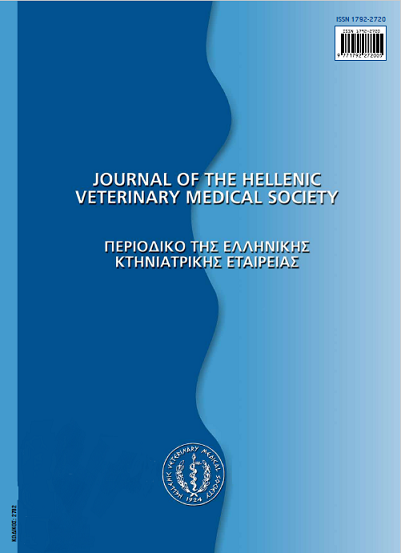Case of unilateral hypoplasia and atresia of the right uterine horn of a gilt
Résumé
A case of unilateral hypoplasia and atresia of the uterus horn was described in 19 months old gilt. After repeated returns and 9, in total, unsuccessful artificial inseminations, during and after the third oestrus, the gilt was slaughtered and the right horn of the uterus was found to be "blind" at the level of its borders with the uterus body. It contained 150ml of fluid and was about half the length of the left horn (110cm vs. 190cm). Diffused and welloutlined cysts were observed in both horns of the uterus. Histological examination revealed in the endometrium, edema with abundant loose cellular stroma that surrounded numerous hypoplastic glands and hyperaemic blood vessels with thick walls. It is suggested that the production of PGF2a by the hypoplastic and "blind" horn of the uterus interrupted the pregnancy in the left horn.
Article Details
- Comment citer
-
XYLOURI-FRAGIADAKI (Ε. ΞΥΛΟΥΡΗ-ΦΡΑΓΚΙΑΔΑΚΗ) E., MENEGATOS (Ι. ΜΕΝΕΓΑΤΟΣ) J., & SABATAKOU (Ο. ΣΑΜΠΑΤΑΚΟΥ) O. (2017). Case of unilateral hypoplasia and atresia of the right uterine horn of a gilt. Journal of the Hellenic Veterinary Medical Society, 54(1), 57–62. https://doi.org/10.12681/jhvms.15219
- Numéro
- Vol. 54 No 1 (2003)
- Rubrique
- Case Report
Authors who publish with this journal agree to the following terms:
· Authors retain copyright and grant the journal right of first publication with the work simultaneously licensed under a Creative Commons Attribution Non-Commercial License that allows others to share the work with an acknowledgement of the work's authorship and initial publication in this journal.
· Authors are able to enter into separate, additional contractual arrangements for the non-exclusive distribution of the journal's published version of the work (e.g. post it to an institutional repository or publish it in a book), with an acknowledgement of its initial publication in this journal.
· Authors are permitted and encouraged to post their work online (preferably in institutional repositories or on their website) prior to and during the submission process, as it can lead to productive exchanges, as well as earlier and greater citation of published work.








